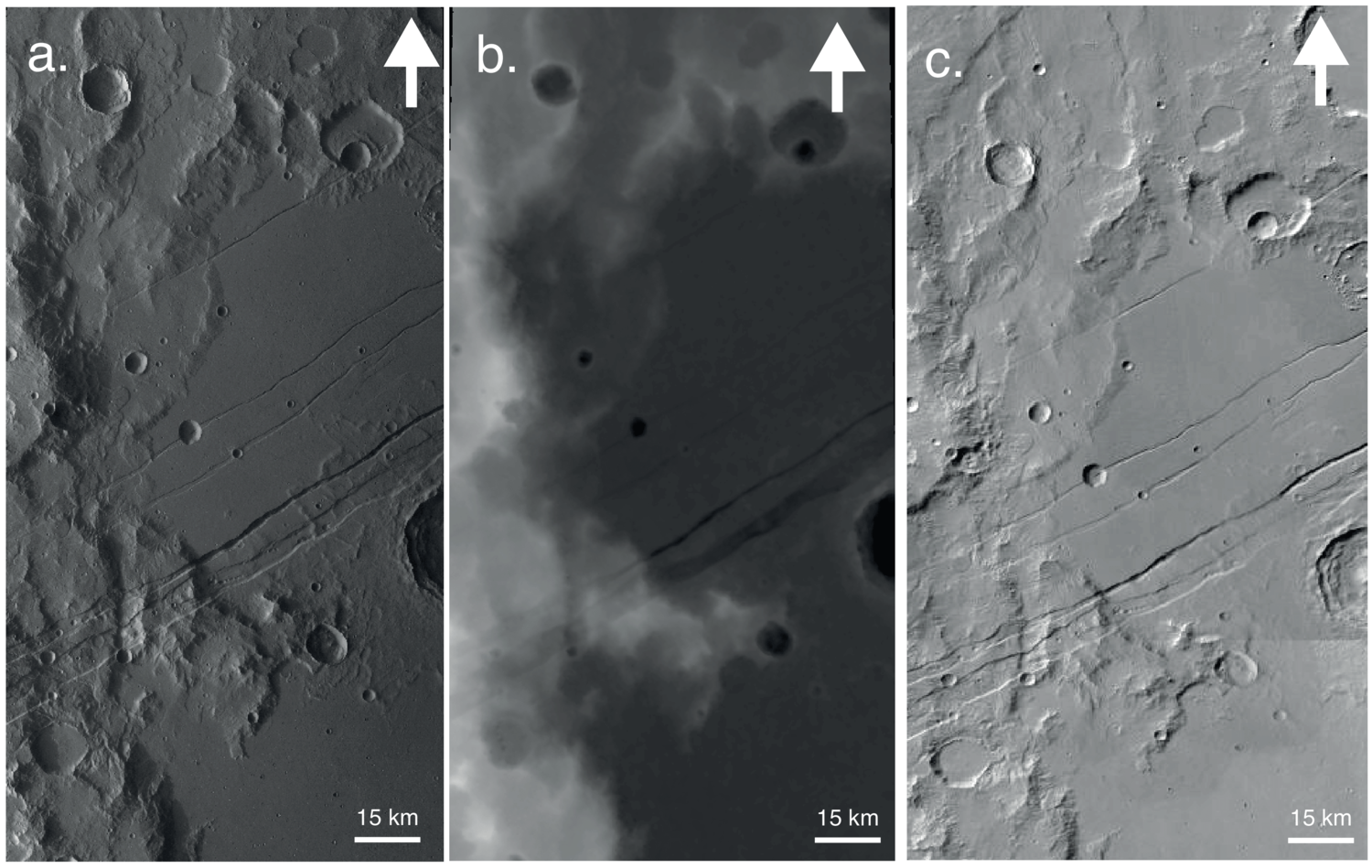Fault scaling at Memnonia Fossae, Mars: Displacement-length relationship derived from HRSC data
- DLR, Berlin, Germany (Isik.Yazici@dlr.de)
Fault population studies are essential to investigate lithospheric strength and stress conditions [1]. Understanding the displacement-length relationship of faults helps us to understand the lithosphere and stress states, and may inform on the stratigraphy of crustal rocks [2]. However, the number of slip events, linkage, and reactivation may affect the Dmax/L ratios [3]. The investigation of current seismicity on Mars is the motivation for a renewed and detailed analysis of the fault systems of Mars. Using Digital Elevation Models (DEM) and corresponding orthoimages derived from High Resolution Stereo Camera (HRSC) data, we obtained information on the displacement distribution on fault traces as well as the maximum displacement. The Dmax/L ratio is calculated as ~0.007, consistent with previous measurements of martian faults (0.006; [4]). Based on these analyses, we discuss the implications of fault segmentation and linkage for further interpretation.
IntroductionDetailed investigation on geometric fault properties can provide insights into the mechanical and temporal evolution of fault systems [5,6], and the past and future potential for seismic energy release [7]. In planetary science, where a lack of seismometers is unfortunately the rule rather than the exception, the analysis of faults with remote sensing data typically provides the only direct observational evidence to constrain the tectonic history of a planet [1]. Since the seismic moment released during the growth of a fault is strongly connected to the fault geometry, the study of fault populations can also help to estimate the current seismicity level [2,8]. Until today, only a few data on the relationships between fault displacement and length have been collected for extraterrestrial bodies [9], partly due to the limited number of reliable topographic datasets.
The InSight mission put a lander in the Elysium region of Mars in 2018. It is equipped with a seismometer [10] that has recorded several marsquakes for which the locations could be determined [11]. As a starting point for our analysis of fault geometries, we selected the Memnonia Fossae fracture system, one of the closest fracture sets to the InSight landing site, which radiates outward from the Tharsis region in a southwesterly direction.
Data and MethodsAll topographic measurements in this study are based on Digital Elevation Models (DEM) based on HRSC data (High Resolution Stereo Camera; [10]). As HRSC is a push-broom scanning instrument with nine CCD line detectors mounted in parallel on a focal plane, its unique feature is the ability to obtain imaging data at high resolution, with along-track triple stereo, four colors and five different phase angles. The spatial scale of HRSC is 10 m/pixel at the nominal periapsis altitude of 250 km, with an image swath of 53 km.

Figure 1: Images show faults from Memnonia Fossae region with three different image system: a. Orthoimage from HRSC, b. DEM derived from HRSC data, c. CTX image.
We use DEM and orthoimages from HRSC [10] to obtain information on the displacement distribution along fault traces. This also enabled determining the maximum displacement. We compare our results to previous measurements of faults on Mars, Earth, and beyond. Based on these analyses, we discuss the implications of fault segmentation and linkage for further interpretation. HRSC data offer high-resolution topography and spatially contiguous coverage, which are required to analyze detailed topographic characteristics of large fault systems. For structural interpretation of key locations (e.g., relay ramps), CTX images (~5-6 m px-1) have been inspected. Fault length was digitized along the fault line, and multiple topographic cross-sections across the fault were drawn with a spacing of ~1 km. Fault throw (a proxy for true displacement) was visually determined in the digitized cross-sections.
Results
At the time of writing, 16 images out of 75 available images/DEM from the Memnonia Fossae region exhibiting normal faults have been investigated. In this preliminary stage, a total number of 83 faults in Memnonia Fossae were studied. We find an average Dmax/L ratio of 0.007, consistent with our previous findings for other regions on Mars, where this ratio had an average value of 0.006 [4].
References
[1] Schultz, R.A. et al. (2010) J. Struct. Geol., 32, 855-875. [2] Golombek, M.P. et al. (1992) Science 258, 979-981. [3] ] Kim, Y., Sanderson, D. J. (2005) Earth Sci. Reviews, 68, 317-334. [4] Hauber, E. et al. (2014) Lunar Planet. Sci. Conf. 45, #1981. [5] Cartwright, J. A., et al., J. Struct. Geol. 17, 1319-1326, 1995. [6] Cowie, P.A. and Scholz, C.H., J. Struct. Geol. 14, 1133-1148, 1992. [7] Wells, D.L. and Coppersmith, K.J. (1994) Bull. Seismol. Soc. Amer., 84, 974-1002. [8] Knapmeyer, M. et al. (2006) J. Geophys. Res., 111, E11006. [9] Schultz, R.A. et al. (2006) J. Struct. Geol., 28, 2182-2193. [10] Lognonné, P., et al., (2019) Space Science Reviews, 215(1), 1-70. [11] Drilleau, M., et al., (2021) EGU General Assembly. Conf. 14998. [12] Gwinner et al., Planetary and Space Science 126 (2016) 93–138.
How to cite: Yazici, I., Hauber, E., and Tirsch, D.: Fault scaling at Memnonia Fossae, Mars: Displacement-length relationship derived from HRSC data, Europlanet Science Congress 2022, Granada, Spain, 18–23 Sep 2022, EPSC2022-1105, https://doi.org/10.5194/epsc2022-1105, 2022.

